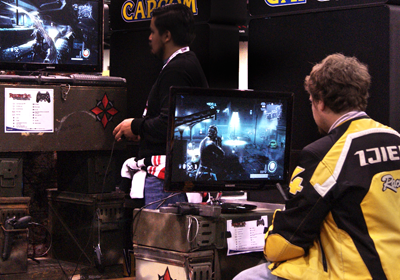Abstract
Male or female? Fat or skinny? Outgoing or quiet? What is your stereotype of a "gamer"? Do your friends have the same mental picture of gamers? How about your parents? This science fair project will help you examine whether the stereotypes of "gamers" actually matches the reality of who plays video games.Summary
Sandra Slutz, PhD, Science Buddies

Objective
In this science fair project, you'll survey people to determine what the stereotype of a gamer is, and how that matches the reality of who a gamer really is.
Introduction
Do you know any gamers? Are you a gamer? Gamer is a label often applied to a person who plays a lot of video games. But like most labels, it also comes with several other assumptions about the people who fall into that category. The assumptions can be about certain physical traits, behavior patterns, and/or personalities. The sum total of traits associated with a label is called a stereotype.
Everyone creates stereotypes in their minds. Sociologists consider stereotypes to be mental "shortcuts," which easily allow individuals, or even cultures, to quickly sort people into groups. Stereotypes are often shared by people of the same culture. Humor and art often rely on social stereotypes. By themselves, stereotypes are not necessarily good or bad, but throughout history, there are examples of stereotypes being used to foster prejudice and discrimination.
 Image Credit: Used with permission; Rebecca Narvaez (Bio-Rad)
Image Credit: Used with permission; Rebecca Narvaez (Bio-Rad)
Figure 1. Do these game-playing attendees of WonderCon match your stereotype of "gamers," or do you think they are just casual video game players? Is there a difference? (Photo courtesy of Rebecca Narvaez and CAPCOM CO. LTD at Wonder Con 2012)
What do you think the stereotype of a gamer is? Does everyone have the same stereotype in mind about gamers, and how accurate is it? You can find out in this science fair project by carrying out your own sociological study of the gamer stereotype. You'll need to create and administer two surveys. In the first survey, you'll collect data about what traits people associate with gamers. Then you'll survey people who actually play video games to determine whether those stereotypes are true. For example, on the first survey, you might ask "On average, how many hours per week does a gamer spend playing games?". Then on the second survey, you'll ask the people who play video games, "On average, how many hours per week do you spend playing games?". By comparing the answers from the two surveys, you'll see how closely the stereotypes and reality match.
Terms and Concepts
- Gamer
- Stereotype
- Sociologist
- Prejudice
- Discrimination
- Demographic
- Structured question
- Non-structured question
Questions
- Why do people create stereotypes?
- How are stereotypes used?
- Based on your own experiences, how well do you think people's stereotypes of gamers will reflect the demographics of people who play games? Why?
- What data already exists describing the game-playing habits and characteristics of people?
Bibliography
A sociology textbook is a good place to learn more about stereotypes and their roles in society. These websites also provide some information about what stereotypes are:
- Kubik, J. and Kubik, M.F. (2003). Global Citizen 2000: Why Study Stereotypes?. Retrieved September 27, 2008.
- Kubik, J. (2003). Global Citizen 2000: Stereotypes Glossary. Retrieved September 27, 2008.
- ChangingMinds.org. (2008). Stereotypes. Retrieved September 27, 2008.
These websites provide more information about gamers and previous studies regarding game-playing demographics:
- Wikipedia Contributors. (2008, September 27). Gamer. Wikipedia: The Free Encyclopedia. Retrieved September 27, 2008.
- Entertainment Software Association. (2017). 2017 Sales, Demographics and Usage Data: Essential Facts About the Computer and Video Game Industry. Retrieved March 15, 2018.
This website offers more information about the chi-square test:
- Wikipedia Contributors. (2008, September 19). Pearson's chi-square test. Wikipedia: The Free Encyclopedia. Retrieved September 27, 2008.
Materials and Equipment
- Surveys, details on how to make these are discussed in the Experimental Procedure below. You'll need enough copies for all your survey participants (minimum of 50 copies).
- Writing utensils (10)
- Clipboards (5, optional)
- Volunteers (minimum of 50)
- Lab notebook
- Graph paper
Experimental Procedure
In this science fair project, you will survey people to determine if there is a difference between the public perceptions of who a gamer is and the demographics of people who actually play video games. You can tailor your survey to get at the specific aspects of the gamer stereotype you're most interested in; for example, appearances, social interactions, behavior, or gaming preferences. Or design a more general survey that broadly covers many of these aspects. The way you design your survey will determine the exact direction of your research.
Designing the Surveys
Before you start designing your surveys, make sure you've read the guide on Designing a Survey.
-
To start this science fair project, you should first decide whether you are going to ask structured (fixed-response) questions or non-structured (open) questions.
- Structured responses are easier to tabulate later for data analysis, but limit the responses to a predetermined list of options you've already thought of.
- Non-structured questions are more challenging to categorize during data analysis, but gather the most specific data, since each volunteer writes his or her own answer without preset limits.
- It is fine for your survey to have a mixture of both structured and non-structured questions if this best fits your data-collection needs.
-
The aim of Survey 1 is to discover what the stereotype of a gamer is. Write questions that address aspects of the gamer stereotype that you are interested in exploring. Some ideas for areas to focus on are:
-
Personal details
- Age
- Gender
- Employment
-
Physical description
- Hairstyle
- Clothing choices
- Body build
-
Social description
- Personality types, such as outgoing or shy
- Number of friends
- Hobbies (besides games)
-
Gaming details
- Types of games played
- Average number of hours spent playing games per week
- Make sure your questions are clear and concise.
- Try to limit the number of questions to 12 or fewer. If your survey is too long, people might not be willing to take the time to complete it.
-
Personal details
-
The aim of Survey 2 is to find out how people who self-identify as gamers describe themselves in relation to the same questions.
-
The questions should be personal questions that address the same aspects of the gamer stereotypes as you queried in Survey 1.
- For example, if Survey 1 asks, "Most gamers are: 1) Male, 2) Female, or 3) Equally likely to be male or female", Survey 2 should ask ask: Your gender is: 1) Male, or 2) Female.
- Each question on Survey 2 should have a related question on Survey 1.
- When writing the questions, be aware that some words have connotations that people don't like and they may be reluctant to use them to describe themselves (or others), even if they think it's the truth. For example, someone might be reluctant to say they are a "picky" eater, but be comfortable stating that there are "many foods I prefer not to eat."
-
The questions should be personal questions that address the same aspects of the gamer stereotypes as you queried in Survey 1.
- When you are done creating your surveys, have one or more people proofread them to make sure they are easy to understand and accurate.
Collecting and Analyzing Survey Responses
- Have as many volunteers as possible (a minimum of 50) fill out each of the surveys.
-
To obtain the large number of volunteers, you could distribute the surveys in a public place, like a mall or outside of a library. Alternatively, collect responses from friends, classmates, teammates, family members, and other groups of people you know.
- Make sure to have plenty of copies of your surveys on hand, as well as clipboards and writing utensils to make it easier for people to fill out the surveys.
- Ask each volunteer if he or she plays video games or not. Have people who do not play any video games fill out Survey 1 and people who do play video games fill out Survey 2.
- Create a bar graph or pie chart representing the answers given for each question on each survey.
-
Compare the results between paired questions on Survey 1 and Survey 2.
-
Is the distribution of the results similar? Which questions were answered most similarly by video game players versus non-gamers? Which responses were most disparate?
- Optional: To analyze the data in a statistical manner, try using the Pearson's chi-square test for each question. The goal will be to use the test to assess the fit between the stereotype data from Survey 1 (which will be the theoretical distribution) and the real data from gamers from Survey 2 (the observed frequency distribution). For more information on Pearson's chi-square test, consult a statistics book or try http://en.wikipedia.org/w/index.php?title=Pearson%27s_chi-square_test&oldid=239481267.
- What do your results indicate about the accuracy of the gamer stereotype?
-
Is the distribution of the results similar? Which questions were answered most similarly by video game players versus non-gamers? Which responses were most disparate?
Ask an Expert
Variations
- Find existing survey data and reports about who plays video games, what kinds of video games they play, etc. (Two such reports are referenced in the Bibliography.) Design and administer your own survey, based on those reports. Are your findings consistent with the existing research? Why or why not?
- Do people who play video games have different assumptions about gamers than people who don't play video games? Design a study to find out.
- Do people who self-identify as gamers feel that they are subject to social prejudice based on their hobby? Design a study to find out.
Careers
If you like this project, you might enjoy exploring these related careers:
Related Links
- Science Fair Project Guide
- Other Ideas Like This
- Video & Computer Games Project Ideas
- My Favorites
- Designing a Survey
- Sample Size: How Many Survey Participants Do I Need?









